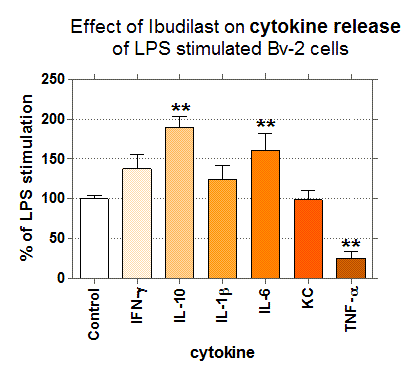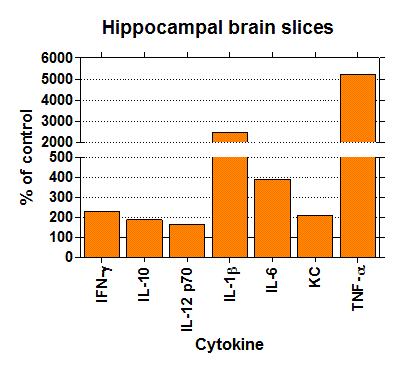Neurodegenerative disorders, including multiple sclerosis (MS), Alzheimer’s disease (AD), Parkinson’s disease (PD), Huntington’s disease (HD), amyotrophic lateral sclerosis (ALS), tauopathies, and age-related macular degeneration (ARMD), are associated with chronic neuroinflammation and elevated levels of several cytokines.
Chronic neuroinflammation includes not only long-standing activation of microglia and subsequent sustained release of inflammatory mediators, but also the resulting increased oxidative and nitrosative stress.
Cytokines constitute a significant portion of the immuno- and neuromodulatory messengers that can be released by activated microglia. QPS Austria provides several cell culture systems including the microglial cell line BV-2, primary mouse microglia or organotypic brain slices (hippocampus or whole brain). All of these are suitable for testing the anti-inflammatory effects of your developmental compounds.
Murine microglial BV-2 cells are stimulated with LPS for 24h in the presence or absence of a test item (e.g. Ibudilast). The inflammatory response is determined by the release of various cytokines in the supernatant or/and in cell extracts using multiplex cytokine arrays. A huge panel of inflammatory mediators can be detected among these IFN-gamma, IL-1beta, IL-6, IL-10, KC, TNF-alpha.

Figure 1: Immuno-modulatory effects of Ibudilast on various cytokines in LPS stimulated BV-2 cells.

Figure 2: Cytokine detection of organotypic hippocampal brain slices upon LPS stimulation.
A common feature of neurodegenerative and neuropsychiatric diseases like schizophrenia or attention deficit and hyperactivity disorder is an increased inflammatory response of the brain. Causes may vary from an exposure to proinflammatory agents during development or an accumulation of degenerated neurons, oxidized proteins, glycated products, or lipid peroxidation in the adult brain.
Therefore, modulation of the prooxidant-antioxidant balance provides a therapeutic option which can be used to improve neuroprotection in response to oxidative stress. Consequently, the role of redox molecules, such as NO and ROS, as key mediators of immunity has renewed attention.

Figure: (Left) Effects of Ibudilast on NO release in LPS stimulated BV-2 cells. (Right) Effects of ascorbic acid on ROS detection in FeCl2 stimulated SH-SY5Y cells.
